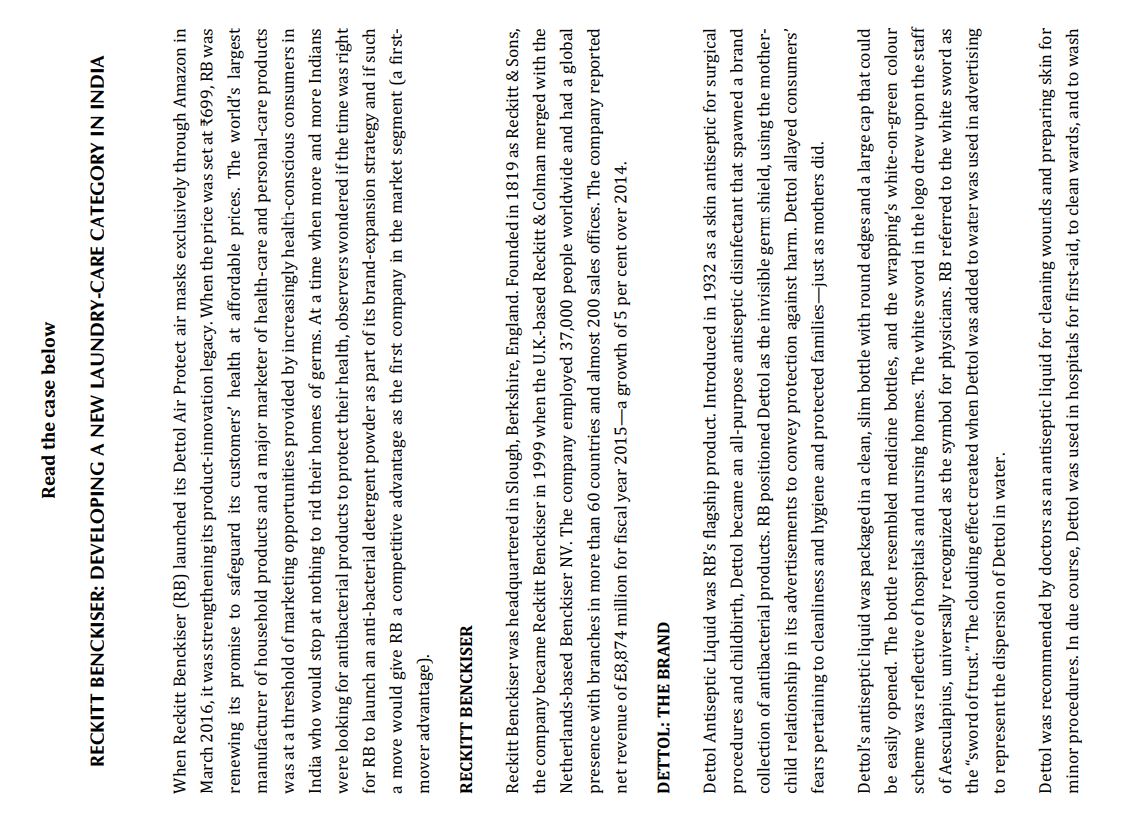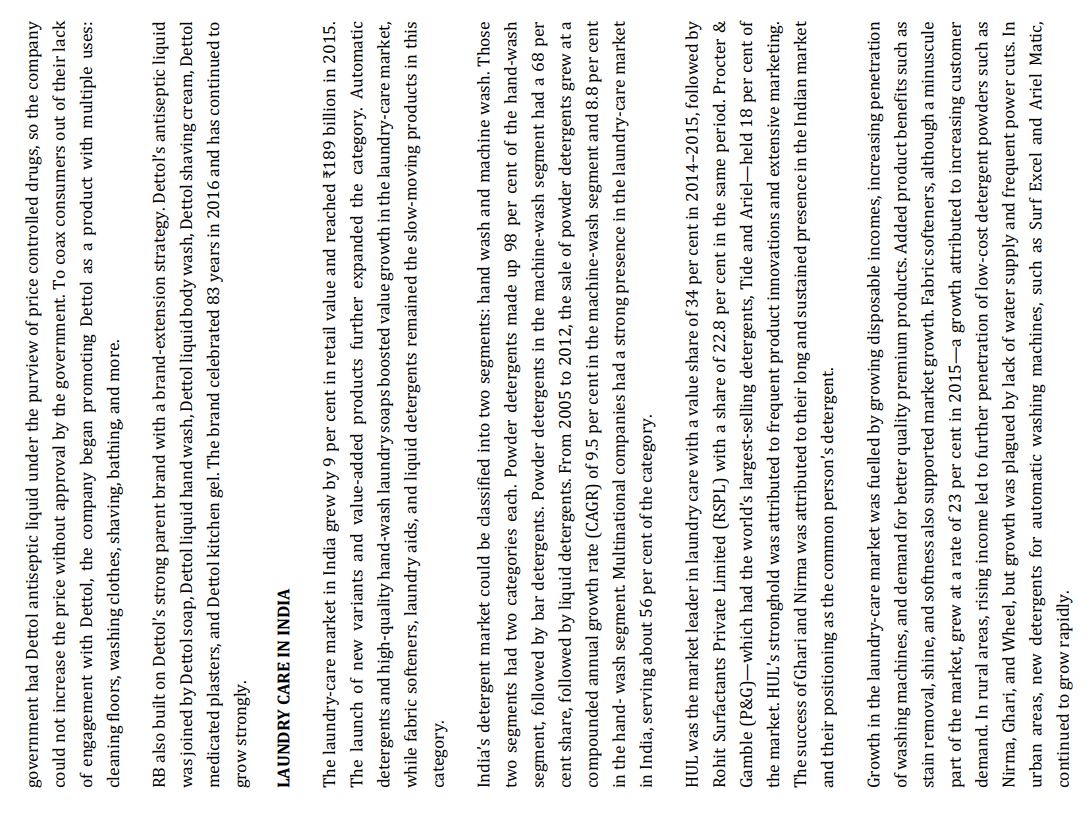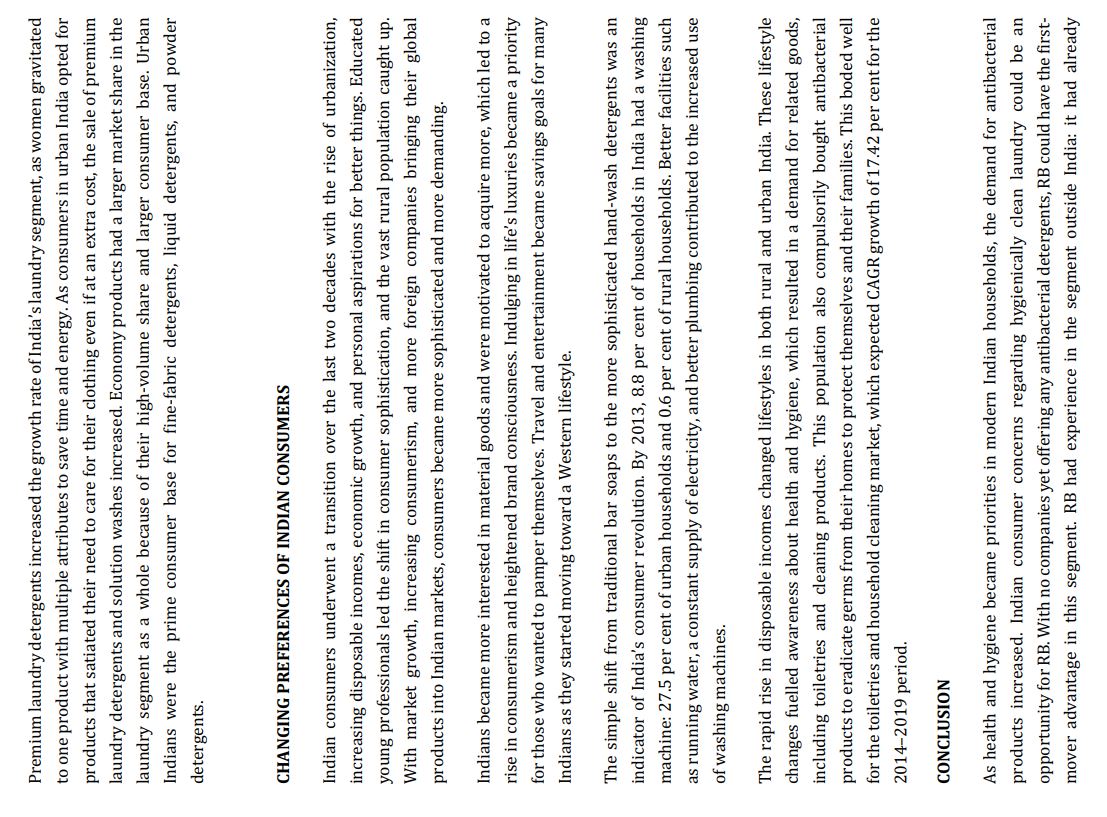Read the case below RECKITT BENCKISER: DEVELOPING A NEW LAUNDRY-CARE CATEGORY IN INDIA When Reckitt Benckiser (RB) launched its Dettol Air Protect air masks exclusively through Amazon in March 2016, it was strengthening its product-innovation legacy. When the price was set at $699, RB was renewing its promise to safeguard its customers' health at affordable prices. The world's largest manufacturer of household products and a major marketer of health-care and personal-care products was at a threshold of marketing opportunities provided by increasingly health-conscious consumers in India who would stop at nothing to rid their homes of germs. At a time when more and more Indians were looking for antibacterial products to protect their health, observers wondered if the time was right for RB to launch an anti-bacterial detergent powder as part of its brand-expansion strategy and if such a move would give RB a competitive advantage as the first company in the market segment (a first- mover advantage). RECKITT BENCKISER Reckitt Benckiser was headquartered in Slough, Berkshire, England. Founded in 1819 as Reckitt & Sons, the company became Reckitt Benckiser in 1999 when the U.K.-based Reckitt & Colman merged with the Netherlands-based Benckiser NV. The company employed 37,000 people worldwide and had a global presence with branches in more than 60 countries and almost 200 sales offices. The company reported net revenue of 68,874 million for fiscal year 2015-a growth of 5 per cent over 2014. DETTOL: THE BRAND Dettol Antiseptic Liquid was RB's flagship product. Introduced in 1932 as a skin antiseptic for surgical procedures and childbirth, Dettol became an all-purpose antiseptic disinfectant that spawned a brand collection of antibacterial products. RB positioned Dettol as the invisible germ shield, using the mother- child relationship in its advertisements to convey protection against harm. Dettol allayed consumers' fears pertaining to cleanliness and hygiene and protected families-just as mothers did. Dettol's antiseptic liquid was packaged in a clean, slim bottle with round edges and a large cap that could be easily opened. The bottle resembled medicine bottles, and the wrapping's white-on-green colour scheme was reflective of hospitals and nursing homes. The white sword in the logo drew upon the staff of Aesculapius, universally recognized as the symbol for physicians. RB referred to the white sword as the "sword of trust." The clouding effect created when Dettol was added to water was used in advertising to represent the dispersion of Dettol in water. Dettol was recommended by doctors as an antiseptic liquid for cleaning wounds and preparing skin for minor procedures. In due course, Dettol was used in hospitals for first-aid, to clean wards, and to washlinen. Patients could see the use of Dettol and followed doctors' recommendation by buying the product for use at home. According to Kiran Khalap, founder of Chlorophyll Brand & Communication Consultancy, Dettol represented the new, allopathic perspective that germs caused diseases-a departure from the historical view that disease was caused by an imbalance in the body. As Indian society became more accepting of the modern view, it was common to be told not just to use Dettol on wounds but also to bathe in Dettol-dissolved water after coming in from the heat and dust outside and to use Dettol for cleaning toilets and household surfaces. The brand continued to stay contemporary through the launch of a breadth of products such as bar soaps, hand sanitizers, liquid hand washes, shower gels, and antibacterial wipes. In 2013, Dettol even entered the dishwashing arena with a kitchen cleaning gel. Even though the brand evolved over the years, the core message for customer engagement remained consistent. Consumers saw Dettol as an effective and versatile "expert," an image RB reinforced with its tag line "Be 100% Sure." Through its advertisements, Dettol also enjoyed the emotional appeal of a mother's love and care for a hurt child. RB constantly projected Dettol as a product that cares about families, just as mothers do, and allayed the fears of consumers pertaining to cleanliness and hygiene. As the world's leading brand of antiseptics, Dettol offered high anti-germ standards, and health-care professionals recommended it for its proven ability to keep families healthy. Dettol was voted India's most trusted brand numerous times. In 2013, Dettol was ranked second on the list of most trusted brands, compiled by Economic Times' Brand Equity. DETTOL ANTISEPTIC LIQUID The antiseptic liquid market in India was estimated at $3.5 billion in February 2015. The market was dominated by Dettol, which had more than 80 per cent of the share. Johnson & Johnson's Savlon Antiseptic was the other significant product, with a market share of 15 per cent. The antiseptic liquid was the first product launched under the Dettol brand in India in 1933. The liquid's distinctive smell was associated with cleanliness and hygiene-an association so entrenched in people's mind that the Dettol smell was a stamp of proof that a room was medically clean and germ free. The tingling, burning sting that Dettol inflicted when applied on wounds convinced consumers that Dettol was killing the germs and healing the affected area. In contrast, consumers deemed Savion Antiseptic ineffective because it lacked the sting. BRAND EXTENSIONS After five decades of growth, the brand faced stagnation: despite being part of the average consumer's emergency kit, Dettol was rarely used. Another issue was constrained revenue, as the Indiangovernment had Dettol antiseptic liquid under the purview of price controlled drugs, so the company could not increase the price without approval by the government. To coax consumers out of their lack of engagement with Dettol, the company began promoting Dettol as a product with multiple uses: cleaning floors, washing clothes, shaving, bathing, and more. RB also built on Dettol's strong parent brand with a brand-extension strategy. Dettol's antiseptic liquid was joined by Dettol soap, Dettol liquid hand wash, Dettol liquid body wash, Dettol shaving cream, Dettol medicated plasters, and Dettol kitchen gel. The brand celebrated 83 years in 2016 and has continued to grow strongly. LAUNDRY CARE IN INDIA The laundry-care market in India grew by 9 per cent in retail value and reached $189 billion in 2015. The launch of new variants and value-added products further expanded the category. Automatic detergents and high-quality hand-wash laundry soaps boosted value growth in the laundry-care market, while fabric softeners, laundry aids, and liquid detergents remained the slow-moving products in this category. India's detergent market could be classified into two segments: hand wash and machine wash. Those two segments had two categories each. Powder detergents made up 98 per cent of the hand-wash segment, followed by bar detergents. Powder detergents in the machine-wash segment had a 68 per cent share, followed by liquid detergents. From 2005 to 2012, the sale of powder detergents grew at a compounded annual growth rate (CAGR) of 9.5 per cent in the machine-wash segment and 8.8 per cent in the hand- wash segment. Multinational companies had a strong presence in the laundry-care market in India, serving about 56 per cent of the category. HUL was the market leader in laundry care with a value share of 34 per cent in 2014-2015, followed by Rohit Surfactants Private Limited (RSPL) with a share of 22.8 per cent in the same period. Procter & Gamble (P&G)-which had the world's largest-selling detergents, Tide and Ariel-held 18 per cent of the market. HUL's stronghold was attributed to frequent product innovations and extensive marketing. The success of Ghari and Nirma was attributed to their long and sustained presence in the Indian market and their positioning as the common person's detergent. Growth in the laundry-care market was fuelled by growing disposable incomes, increasing penetration of washing machines, and demand for better quality premium products. Added product benefits such as stain removal, shine, and softness also supported market growth. Fabric softeners, although a minuscule part of the market, grew at a rate of 23 per cent in 2015-a growth attributed to increasing customer demand. In rural areas, rising income led to further penetration of low-cost detergent powders such as Nirma, Ghari, and Wheel, but growth was plagued by lack of water supply and frequent power cuts. In urban areas, new detergents for automatic washing machines, such as Surf Excel and Ariel Matic, continued to grow rapidly.Premium laundry detergents increased the growth rate of India's laundry segment, as women gravitated to one product with multiple attributes to save time and energy. As consumers in urban India opted for products that satiated their need to care for their clothing even if at an extra cost, the sale of premium laundry detergents and solution washes increased. Economy products had a larger market share in the laundry segment as a whole because of their high-volume share and larger consumer base. Urban Indians were the prime consumer base for fine-fabric detergents, liquid detergents, and powder detergents. CHANGING PREFERENCES OF INDIAN CONSUMERS Indian consumers underwent a transition over the last two decades with the rise of urbanization, increasing disposable incomes, economic growth, and personal aspirations for better things. Educated young professionals led the shift in consumer sophistication, and the vast rural population caught up. With market growth, increasing consumerism, and more foreign companies bringing their global products into Indian markets, consumers became more sophisticated and more demanding. Indians became more interested in material goods and were motivated to acquire more, which led to a rise in consumerism and heightened brand consciousness. Indulging in life's luxuries became a priority for those who wanted to pamper themselves. Travel and entertainment became savings goals for many Indians as they started moving toward a Western lifestyle. The simple shift from traditional bar soaps to the more sophisticated hand-wash detergents was an indicator of India's consumer revolution. By 2013, 8.8 per cent of households in India had a washing machine: 27.5 per cent of urban households and 0.6 per cent of rural households. Better facilities such as running water, a constant supply of electricity, and better plumbing contributed to the increased use of washing machines. The rapid rise in disposable incomes changed lifestyles in both rural and urban India. These lifestyle changes fuelled awareness about health and hygiene, which resulted in a demand for related goods, including toiletries and cleaning products. This population also compulsorily bought antibacterial products to eradicate germs from their homes to protect themselves and their families. This boded well for the toiletries and household cleaning market, which expected CAGR growth of 17.42 per cent for the 2014-2019 period. CONCLUSION As health and hygiene became priorities in modern Indian households, the demand for antibacterial products increased. Indian consumer concerns regarding hygienically clean laundry could be an opportunity for RB. With no companies yet offering any antibacterial detergents, RB could have the first- mover advantage in this segment. RB had experience in the segment outside India: it had alreadylaunched Dettol Antibacterial Laundry Cleanser in Europe in 2013. P&G was also marketing in this segment outside India, selling Ariel Professional Antibacterial Washing Powder in the United Kingdom. Source: Harvard Business Publishing for Educators











